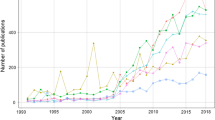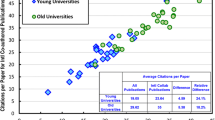Abstract
The issue of primary interest to this study is the collaboration that has taken place in science and technology (S&T) research in China. Due to our empirical evidences, the regions with higher relationship (network) capital enjoy higher knowledge productivity in terms of published articles. Our purpose in this paper is to investigate the relationships that exist between regional published articles and co-authorship in China covering the period from 1998 to 2007 by using Stata to investigate the relation between the regional publications and co-authored published articles. As main findings, the greater the number of co-authored articles that a region has, the greater their success, in terms of the number of articles published. Indeed, both domestic and international co-authorship have had positive effects on published article levels in China.
Similar content being viewed by others
Notes
The function form with two inputs is of the form:
\( P(K,L) = bK^{\alpha } L^{\beta } \) where P = total production, K = capital input, L = labor input, b = total factor production, α and β are the output elasticities of capital and labor, respectively. These values are constants determined by available technology.
The model adopted for this study is also similar to that proposed by Liu and Zhou (2008).
The region of Tibet is excluded from our sample.
References
Acs, Z. J., & Anselin, L. (2002). Varga patents and innovation counts as measures of regional production of new knowledge. Research Policy, 31, 1069–1085.
Adams, J., & Griliches, Z. (1996). Research productivity in a system of universities. NBER Working Paper Series, No. 5833.
Amat, C. B. (2008). Editorial and publication delay of papers submitted to 14 selected food research journals. Influence of online posting. Scientometrics, 74(3), 379–389.
Asheim, B., & Coenen, L. (2005). Knowledge base and regional innovation system: Comparing Nordic clusters. Research Policy, 34, 1173–1190.
Barnett, A. H., Ault, R. W., & Kaserman, D. L. (1988). The rising incidence of co-authorship in economics: Further evidence. Review of Economics and Statistics, 70, 539–543.
Bayer, A. E., & Smart, J. C. (1991). Career publication patterns and collaborative ‘styles’ in American Academic Science. Journal of Higher Education, 62(6), 613–636.
Beaver, D. De B., & Rosen, R. (1978). Studies in scientific collaboration, part 1: The professional origins of scientific co-authorship. Scientometrics, 1, 65–84.
Beaver, D. De B., & Rosen, R. (1979a). Studies in scientific collaboration, part 2: Scientific co-authorship, research productivity and visibility in the French Scientific Elite. Scientometrics, 1, 133–149.
Beaver, D. De B., & Rosen, R. (1979b). Studies in scientific collaboration, part 3: Professionalization and the natural history of modem scientific co-authorship. Scientometrics, 1(3), 231–245.
Cockburn, I. M., & Henderson, R. M. (1998). Absorptive capacity, co-authoring behavior and the organization of research in drug discovery. Journal of Industrial Economics, 46(2), 157–182.
Crespi, G., & Geuna, A. (2004). The productivity of science. Brighton: SPRU Report prepared for the Office of Science and Technology (OST), Department of Trade and Industry (DTI), UK.
Durden, G., & Perri, T. J. (1995). Co-authorship and publication efficiency. Atlantic Economic Journal, 23(1), 69–76.
Endersby, J. W. (1996). Collaborative research in the social sciences: Multiple authorship and publication credit. Social Science Quarterly, 77, 375–392.
Fritsch, M., Slavtchev, V. (2005). The role of regional knowledge sources for innovation—an empirical assessment. Freiberg Working Paper.
Griliches, Z. J. (1979). Issues in assessing the contribution of research and development to productivity growth. Bell Journal of Economics, 10, 92–116.
Griliches, Z. J. (1990). Patent statistics as economic indicators: A survey. Journal of Economic Literature, 28, 1661–1707.
Heck, J. L., & Zaleski, P. A. (1991). Trends in economic journal literature. Atlantic Economic Journal, 1923(1), 27–32.
Hollis, A. (2001). Co-authorship and the output of academic economists. Labour Economics, 8, 503–530.
Hudson, J. (1996). Trends in multi-authored papers in economics. Journal of Economic Perspectives, 10, 153–158.
Jaffe, A. B. (1989). Real effects of academic research. American Economic Review, 79, 957–970.
Laband, D. N., & Tollison, R. D. (2000). Intellectual collaboration. Journal of Political Economy, 108(3), 632–662.
Landy, R., Traore, N., & Godin, B. (1996). An econometric analysis of the effect of collaboration on academic research productivity. Higher Education, 32, 283–301.
Leydesdorff, L., & Fritsch, M. (2006). Measuring the knowledge base of innovation system in Germany in terms of a triple helix dynamics. Research Policy, 35, 1538–1553.
Liu, M.-C., & Zhou, X. (2008). Marketization and the efficiency of regional innovation systems in China. Working paper.
Malerba, F. (2005). Sectoral system of innovation: A framework for linking innovation to the knowledge base, structure and dynamics of sectors. Economics of Innovation and New Technology, 14(1–2), 63–82.
Maske, K. L., Durden, G. C., & Gaynor, P. E. (2003). Determinants of scholarly productivity among male and female economists. Economic Inquiry, 41(4), 555–564.
McDowell, J. M., & Melvin, M. (1983). The determinants of co-authorship: An analysis of the economics literature. Review of Economics and Statistics, 65, 155–160.
Moody, J. (2004). The structure of a social science collaboration network: disciplinary cohesion from 1963 to 1999. American Sociological Review, 69(2), 213–238.
Moravcsik, M. J. (1985). Applied scientometrics: An assessment methodology for developing countries. Scientometric, 7, 165–176.
Pelz, D., & Andrews, F. (1966). Scientists in organizations: Productive climates for research and development. New York: Wiley.
Piette, J. M., & Ross, K. L. (1992). An analysis of determinants of co-authorship in economics. Journal of Economic Education, 23, 277–283.
Price, D. de Solla (1963). Little science, big science. New York: Columbia University Press.
Price, D. de Solla, & Beaver, D. De B. (1966). Collaboration an invisible college. American Psychologist, 21, 1011–1018.
Stanley, A., & Yan, S. (2007). China opening up: Chinese University journals and research: Today and tomorrow. Learned Publishing, 20, 43–50.
Taylor, S. W., Fender, B. F., & Burke, K. G. (2006). Unraveling the academic productivity of economists: The opportunity costs of teaching and services. Southern Economic Journal, 72(4), 846–859.
Zuckerman, H. A. (1965). Nobel laureates: Sociological studies of scientific collaboration. Ph.D. dissertation. Department of Sociology, Columbia University, New York.
Author information
Authors and Affiliations
Corresponding author
Rights and permissions
About this article
Cite this article
Cho, CC., Hu, MW. & Liu, MC. Improvements in productivity based on co-authorship: a case study of published articles in China. Scientometrics 85, 463–470 (2010). https://doi.org/10.1007/s11192-010-0263-z
Received:
Published:
Issue Date:
DOI: https://doi.org/10.1007/s11192-010-0263-z




